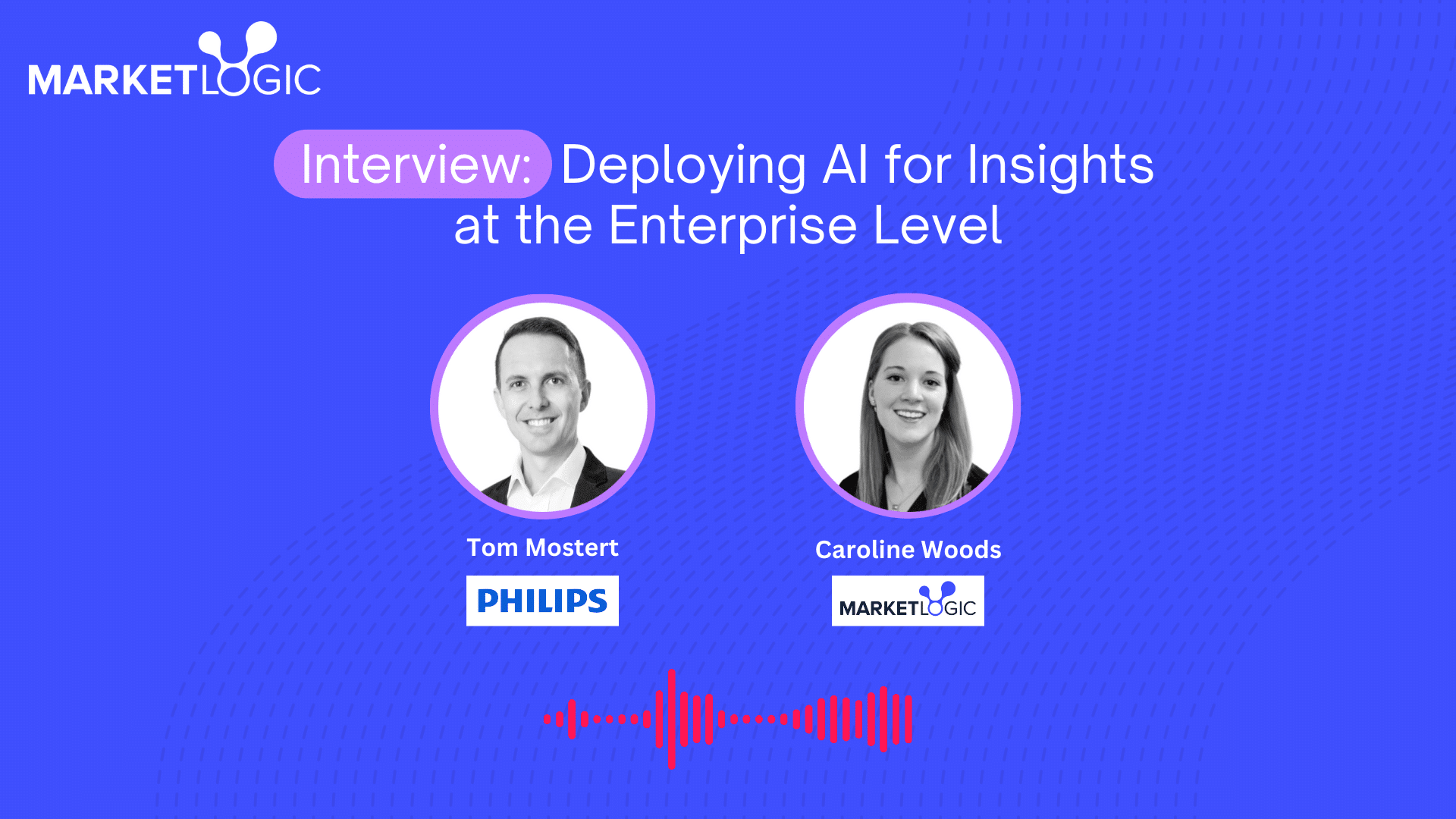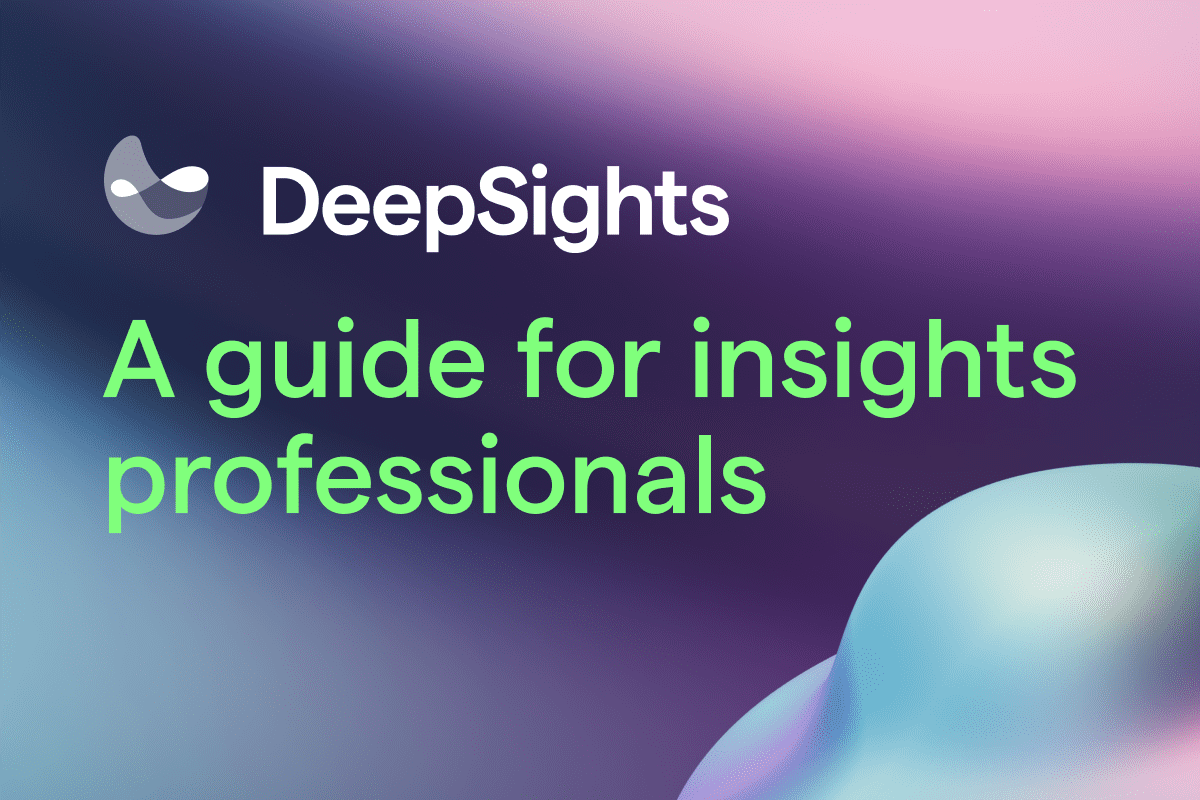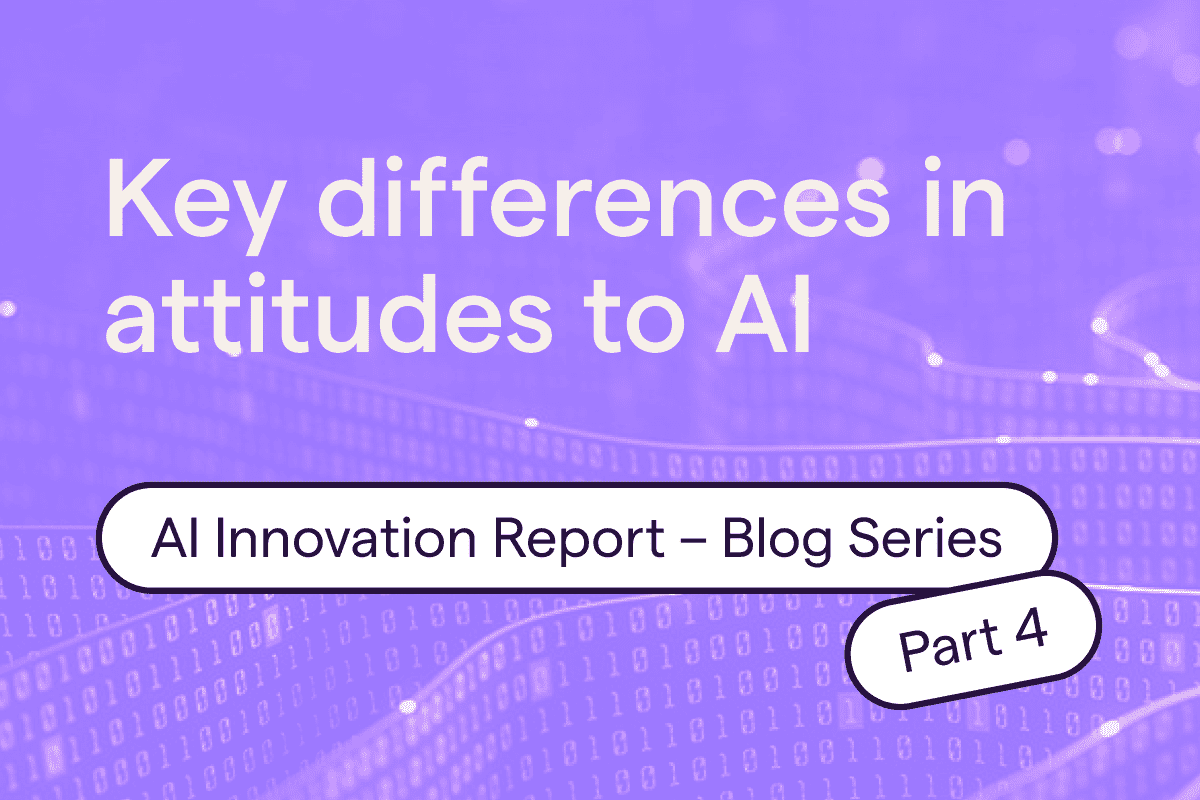I think generative AI is like the dawning of the Age of Aquarius. It’s a completely new way of doing things. I don’t think that that is going to replace human talent. I don’t think it’s going to replace our ability to strategize. But what I do think it is going to differentiate people who adopt this technology from the people who resist the technology. And the people who adopted will definitely have an advantage.
Tom Mostert, Global Head of Competitive & Knowledge Management, Philips
What has Philips discovered in using the DeepSights AI Solution for Insights?
Ahead of our recent webinar, Enterprise Insights in the Age of AI, we sat down for a 1-on-1 interview with Tom Mostert, Global Head of Competitive & Knowledge Management at Philips.
Philips is one of Market Logic’s longstanding partners and has been one of the first to pilot our new generative-AI solution, DeepSights™. In this interview, Tom walks through how his team measured the success and impact of DeepSights, what enterprises should consider when deploying AI tools, and what he believes the future of AI for Insights might look like:
INTERVIEW TRANSCRIPT:
Caroline Woods, Market Logic 0:00
Thank you, Tom, for being with me today. Do you mind just quickly introducing yourself and giving a bit of background into your experience in the insights and market research industry?
Tom Mostert, Philips 0:10
Sure. My name is Tom Mostert. And I’m currently the leader of knowledge management and competitive intelligence for the marketing insights and analytics function within the broader marketing organization of royal Philips based in the Philips headquarters here in Amsterdam.
I joined Philips in 2017, at our hospital patient monitoring operations in Germany, and then in 2020, just before the pandemic clip, I moved to Amsterdam. But I started in the insights and market research industry straight out of university 25 years ago. My first job was with Research International, I don’t know if you’ve heard of them in the South African office. And I spent almost since then two decades of my career, on the supplier side working with various international agencies. But healthcare was an has always been a prominent feature in the body of work that I’ve been involved in, over the past quarter century, essentially, that I’ve been in the insights industry.
I see what we are experiencing now as the dawning of a new era of data analytics using AI. And for the most part, it will probably focus first on making our lives easier by speeding up the automating tasks… and democratizing the vast quantities of data that are currently sitting on servers or cloud servers and in data lakes that remain untapped.
Tom Mostert, Global Head of Competitive & Knowledge Management, Philips
I’ve been thinking about it, I’ve witnessed a lot of change. When I started out, we were using punch cards, I don’t know if you’ve ever seen a punch card to enter survey data. I’m giving my age away a little bit. And the research at that time, all the research data was collected on pen and paper questionnaires. And we use tape recorders for qualitative research, there was a lot of manual work involved in a lot of paper waste, and looking back now. And things have changed so much since then, it has been quite a fun wide witnessing this evolution of the Insight industry, and the digitization. And the data to incite process, just thinking back into Survey Monkey went mainstream in the mid 2000s. A lot of people predicted then that market research as an industry was dead, and that self service online surveys will completely replace it. And it was certainly a revolution at a time and the impact was huge. But they were wrong about the outcome, the insights industry just simply evolved. The same happened when smartphones in the market and mobile app started collecting Big Data, people were saying that market research will be replaced because we can now learn everything that we need to know from big data, recorded real world evidence at the time because it was based on actual behavior was recorded almost in real time.
So I see what we are experiencing now as the dawning of a new era of data analytics using AI. And for the most part, it will probably focus first on making our lives easier by speeding up the automating tasks. The tasks that have already been digitized can be more automated, and also further democratizing the vast quantities of data that are currently sitting on servers or cloud servers and in data lakes that remain untapped. What comes next? We can tell, but I’m certainly looking forward to being part of that journey.
Caroline Woods, Market Logic 3:40
Yeah, so it sounds like you know, with your experience, you’re no stranger to implementing new kinds of technologies and expanding what research and insights means rather than using these technologies to replace it. So generative AI for insights, I’m wondering What convinced you and your team at Philips to that now is the time to start implementing and experimenting and exploring generative AI tools on top of your existing research and insights management solutions.
Tom Mostert, Philips 4:12
Great question. Generative AI. It’s it’s quite a buzzword right now to a very large extent, thanks to OpenAI and the launch of chat GPT, which we can probably describe as the “iPhone moment” of scaling user operated AI applications to mainstream mass market and democratizing access to petabytes of digitized information to a very wide population while using a very familiar and human friendly interface. But AI itself has been around for quite a long time already and it’s used everywhere. But it’s intrusion into our everyday lives has been not that recognizable because for the most part, it has been a slow creep.
If you think about Google search and GPS navigation, social media algorithms, these things started rather simple. And then they got better over time. But they weren’t that many Big Bang events like there was now with with generative AI.
So the same can be said about how we have been using AI applications. In our insights management solutions. We’ve been using search. And we’ve been using navigation, machine learning to understand user behavior to on our digital platforms to shorten the insights discovery pathway. And this happens in waves that usually last about two to five years depending on the effectiveness of the solution. So I think about a decade ago, the enterprise needs for insights, management used to be quite simple. Then we needed an archive solution that was that could be scalable and searchable to store all sorts of knowledge and insight assets. We had different solutions with varying degrees of effectiveness, but the data was fractured still, and siloed. And for the most part, still difficult to find, then, I believe, as a direct result of the success of social media platforms, that we’re able to personalize content.
Generative AI is opening up these new possibilities… it goes a lot further in the interpretation and summary of large volumes of language format information, and produces output in natural language that can immediately be absorbed and shaped by human users. So this is a significant step in the I would call that the “anthropomorphization” of this technology.
Tom Mostert, Global Head of Competitive & Knowledge Management, Philips
Also, the widespread adoption of meta-tagging and content sharing, the demand for content personalization started to grow. And four years ago, we decided to consolidate that the existing asset libraries into a single solution that was capable of customizing the user experience on a user level and use more advanced metadata to automate the data discovery journey, and shorten that plot that I was talking about. And that’s when we started also the journey with market logic. So now with the existing platform, sort of pre AI generative AI, the process still requires a fair amount of user side adaptation to enable these platforms to perform optimally. Searches cannot be too complex, and work best if the user knows how to use Boolean logic and operators in their search queries.
Now, things are changing and generative AI is opening up these new possibilities, because it’s going a few steps further, not only does it do a really great job at search and discovery based on natural language input queries. But it also goes a lot further in the interpretation and summary of large volumes of language format information, and produces output in natural language that can immediately be absorbed and shaped by human users. So this is a significant step in the I would call that the “anthropomorphization” of this technology.
Caroline Woods, Market Logic 8:02
I think that’s a good term for it. And I think one of the things that’s been fascinating to watch is the way that your team has created this test environment to play around with deep sights, which is, of course, the market logic generative AI tool. So I’m wondering if you can talk a little bit about how you guys have systematically compared DeepSights to the other more perhaps well known generative AI solutions on the market, such as ChatGPT or Bing, and what feedback you’ve received from the pilot team so far?
Tom Mostert, Philips 8:36
Yes, I think I’ll give a little bit of background about how we did the testing. So the original brief was not necessarily to do this comparative tasting. That was something that we came up with, because we really wanted, it was it actually when we started the conversation about testing deep sights. I think that was even before being launched their solution on Microsoft browser, and ChatGPT was still really, really new. And so everybody that was involved in the testing was practically unfamiliar with generative AI as a means of extracting insights from large volumes of Library Information. So we decided, okay, we’ve got the one that we were tasting part of the Eureka platform, and the other two that were provided by other external providers that we’re free to use for the public. And it would be very interesting to compare what they could do.
We found that the ChatGPT AI was the most powerful platform in terms of generating comprehensive well structured output. But very big caveat, it does not reference the sources so you cannot check the logic and we have already heard about all the problems that people have been experiencing. A generative AI is not designed to give a non response. It does not say I don’t know, therefore, specifically ChatGPT. Some of them now do but ChatGPT will make up stuff, if it doesn’t find the answer for you. And it does. So by fitting your criteria, the input criteria with available information, and then filling in the gaps using creative wording. And that doesn’t necessarily make for a very reliable source of information.
The DeepSights plugin that we tested provided the balance between the two [ChatGPT and Bing]; it only draws the answers from our library of vetted and validated information that we gave it and therefore provided the most accurate and the most appropriate responses to the queries that we we put in there.
Tom Mostert, Global Head of Competitive & Knowledge Management, Philips
So compare that to being which actually does give the sources of information, we found that Bing gave more reliable and more useful answers, and also still quite comprehensive. And you could check where it got that information from. But then the problem came in that the information that was provided by the big platform, also, because it’s open to the entire internet practically. And there’s a lot of crap information on the internet, there’s a lot of unreliable information, you get all reports that you get completely a junk information that was designed for either sales or marketing purposes or some other nefarious purpose. But it doesn’t discriminate between what is really reliable information and what is unreliable information.
And then you get to the DeepSights plugin that we tested and it provided the balance between the two; it only draws the answers from our library of vetted and validated information that we gave it and therefore provided the most accurate and the most appropriate responses to the queries that we we put in there. But on the other hand, there were limitations to the extent of the answers. But I do believe that these can be overcome in time as the library of content that it has to draw from increases.
Caroline Woods, Market Logic 12:07
My understanding is that you had a select subset of your asset library that you uploaded to the deep sites pilot, um, do you know kind of what went into how you selected the documents and the queries that you were going to be testing out? What was the thinking that went into that?
Tom Mostert, Philips 12:27
That was a difficult problem to solve in the beginning, because when we were offered this opportunity to test deep sites, we had to decide whether we wanted to go for general questions based on something like the most popular questions, but because of the complexity within Philips, that the range of information that we have is so broad, we would have had to put the entire library in there. So we decided to test deep sites with a theme based topic. And we decided to use ultrasound and patient monitoring. So two healthcare topics, and we asked a few topic experts to provide the best resources that could be used for this. And we ended up I think, with about 150 documents in the library that got tested.
Caroline Woods, Market Logic 13:14
Just in the preliminary usage. What would you say were the unexpected use cases? What were the unexpected challenges that your team initially came across?
Tom Mostert, Philips 13:26
We did not really cost a very wide net in terms of users. So that limited the scope for exploring the unexpected areas of the beta test. So we stayed within clearly defined guidelines to ensure that we have comparability and stable test results. I do not think that we colored too much outside of the lines, but I did a little bit of experimentation myself to see if the application could handle strange types of queries. And these weren’t typically recorded in in our feedback. But I did find that it worked well enough when you asked some questions that has little to do with the general topic covered in the connected Library.
In terms of challenges. They were a few challenges, but we expected that they would be challenges, because we didn’t pre define what the challenges would be for testing purposes. One of the first challenges was some of the non responses to queries. And we quickly figured out that the need for critical mass of information was required to enable the platform to generate responses. So as we added additional assets to the reference library, most of these non responses were resolved. Another challenge that we found was the limited range of responses. So how it is designed that there’s a limit built into DeepSights that will produce up to three answers to a question and per answer it may give many references, but from the same source, each answer appears to be a summary of the asset that contains the most relevant information. And therefore, answers do not appear to cover multiple sources of documents.
But on the other hand, when we think about the use cases, for DeepSights, it really would be for people who are looking for a quick answer. And that is the major benefits of the platform is that within seconds, you can get an answer to a question that would otherwise take you half an hour to a couple of hours to answer if you go through regular search. So for the purpose of answering that specific use case, somebody is about to go into an important meeting, or they’re facing a client, a question comes up and they need an immediate answer. It really performed well. And the top three answers that it gave really is sufficient for addressing that use case.

Caroline Woods, Market Logic 16:01
You said at the top that your expectation was that in this first wave of generative AI implementation, time efficiency and automating tasks was going to be the first use case that this really conquered. I see, you know, the idea that deep sights can give a non-answer that actually is a feature that can help research teams, because I’m sure you know, it’s, sometimes it’s helpful to know what you don’t know as what you do know. So I’m interested now looking into the future. As you roll this out, either to other business functions within Philips, or just expand connected libraries and the users, how will the way that you measure the success of this tool evolve over time?
Tom Mostert, Philips 16:43
As with everything in business, it gets measured against the impact that it has. And in this case, time, I think will tell which use cases will provide the most value proved to be the most popular. And we will need to set up new KPIs definitely to measure and track performance and usage under different circumstances. But I think the immediate success will come down to the time saved if you can say for certain that the journey from a question to a solution has been shortened by X number of hours for X number of users, that really frees up a lot of time where the user can focus on the customer, the customer needs identifying solutions for customer problems. And we all recognize that time wasted searching for information is one of the key obstacles for companies to perform better. I think this will really address that.
“We all recognize that time wasted searching for information is one of the key obstacles for companies to perform better. I think [DeepSights] will really address that.”
Tom Mostert, Global Head of Competitive & Knowledge Management, Philips
The next one would be the return on investment. And that’s going to be a challenging one. Because there are so many generative AI solutions coming onto the market. Now, it’s going to be a trade off between the factors that I mentioned to you earlier on, do you want to have a wide but maybe unreliable pool of information? Or do you need really accurate and actionable data to work from, and that will definitely vary from company to company, depending on who their target markets are, and what industry they are in, we are in a highly regulated industry, within healthcare, we don’t have that much room to make mistakes.
So we would prefer to have a solution that we have control over what information it draws upon, rather than something that could draw from information that that could be potentially damaging or harmful to patients. So there are pros and cons. At the end of the day, if we can make an impact on the lives of our customers and our patients, that would be the success driver that would stand to the front.
At the end of the day, if we can make an impact on the lives of our customers and our patients, that would be the success driver that would stand to the front.
Tom Mostert, Global Head of Competitive & Knowledge Management, Philips
Caroline Woods, Market Logic 19:00
Yes, it’s about closing the gap between you and the consumer at the end of the day. I also think healthcare and healthcare adjacent industries are facing the highest level of scrutiny when it comes to regulatory frameworks and privacy and consumer data or patient data. I think that is a huge question when it comes to AI because a lot of people already the the trust that they have in these OpenAI LLMs they don’t know where that data is being pulled from. So, I think if if this is a solution that can work under the scrutiny of the regulatory frameworks in healthcare, that we’re stress testing it in the right, the right environment.
This was a great interview. And again, if we have this conversation in a few months, something like you know, the KPIs that you’re measuring will look completely different. So really interested to see how those evolve. But do you have any final thoughts on generative AI for insights teams? You guys are some of the first to try to implement this on the enterprise level. So, any tips or tricks to people who are taking that first step?
Tom Mostert, Philips 20:10
I think generative AI is like the dawning of the Age of Aquarius. It’s a completely new way of doing things. And ironically, a couple of years ago, I wrote an article about the impact of AI on the market research industry and on the analytics industry. And I speculated a little bit about what impact it is going to have. And at that time, I read the article the other day, and I said, what’s currently taking days to perform this crunch down to hours, I was wrong. It comes down to split seconds now, how quickly it can do things that really took a really long time. I don’t think that that is going to replace human talent. I don’t think it’s going to replace our ability to strategize. But what I do think is it is going to differentiate people who adopt this technology from the people who resist the technology. And the people who adopted will definitely have an advantage.
In the long run, will it take over the world? Will we lose control of it? I don’t know. I hope not. But for now, there are certainly great opportunities for it to make millions of lives better, and relieve the stresses really, maybe gives us a few more hours to go to the beach, spend time with family and do the things that are really important for humans to do. I don’t think we should see it as a threat. But I should think that we should treat it with respect.
Caroline Woods, Market Logic 21:43
That’s a great place to end it. I think less tedious research work, more time at the beach is a great sales pitch. Maybe we’ll will think about integrating a little bit of that. But that’s great feedback. I know that we’re gonna be joining you for a webinar next week on this very topic.
So excited to see what you have to share there. But thank you for for taking this time.
END OF INTERVIEW
Want to hear more on AI & Enterprise Insights?
Want to hear more from our partners and customers on the future of insights? Tom rejoins us alongside some additional customers and partners for the webinar Enterprise Insights in the Age of AI.
You can also learn more about how Philips have leveraged the Market Logic platform to produce engaging, actionable insights here.
Otherwise, you can explore DeepSights™ for yourself and learn more about how generative-AI is transforming the consumer insights and market research industry.







